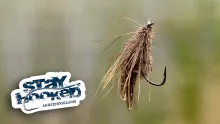A Fly Imitating Free-Roaming Larva--Tied "In The Round" Style for a Halo of Gills Look.
Free-roaming larva from the Net-spinners (Hydropsychidae) and Rock worm (Rhyacophilidae) caddis families vary widely in how many gills line their abdomen—from none to a thicket of gills. The Gilly Caddis imitates those larva that have common gills. The Gilly Caddis imitates both these caddis families because they have a similar size, coloration, profile, life style as well as a dawn and dusk behavioral drift. The Gilly Caddis pattern is tied slim to help it sink to the stream bottom where the heavy beads near the hook eye make it tend to drift head down.
The fly is tied using an "in the round" style—popularized by Charles Brooks in his 1976 book "Nymph Fishing..." This style makes a fly with a round symmetry that shows the same gilly abdomen look to the trout even if the fly is twisting on the leader as it bottom bounces downstream. Thus, a Gilly Caddis constantly projecting its fuzzy white underbelly as it fly drifts along signals a near-universal sign of vulnerability to predators-including trout.
Besides behavioral drift, the life style of these caddis families also promotes catastrophic drift. Hydropsychidae dwell in net-covered retreats but are exposed to drift as they freely move about foraging on the rocks outside of that cover. They are also known to fight each other to occupy the same retreat which leads to the loser being forcibly ejected from the retreat and possibly on into the drift. Rhyacophilidae make no retreat at all and when foraging out in the open can likewise be swept away at anytime. In addition, scientific studies find that caddis larva can be washed into the drift during floods-- as well as during drought when they seek deeper water. And so on. The point is that the life activities of these caddis larvae along with their preferred fast flowing-water habitat promotes drift at any time. As such, caddis larva are an important fish food for the daytime fisherfolk to imitate without having to arrive early for the dawn behavioral drift or stay late for the one at dusk.
Lengthwise, these caddis families overlap in the 12-18mm (1/2" - 3/4") range when mature (Hafele & Roederer, 1995, "Aquatic Insects..." Based on a Tiemco 206BL hook, this length translates to a size 10 -16. The 206BL is used because even a size 10 hook can to take 1.5mm beads (see note in recipe). This feature allows putting small diameter beads on the shank to imitate the thin dark thoracic plates and head found on the diminutive 1.5-3mm tube-like profile seen in the slimmer species of these caddis families. The ratio of thorax+head to abdomen length runs around 1/3 for Hydropsychidae to about 1/4 in Rhyacophila—which translates to using three 1.5mm beads on a size 10-12 hook and two beads on a 14-16.
Coloration of these caddis families is often a shade of green: as expected for larva called "green rock worm." The green color varies from emerald to chartreuse on to olive. Also seen are brown, tan, cream or gray larva. Both caddis groups show a segmentation denoted by a color variation that can be combined with a variable diameter pearl-necklace looking segmentation. As always, screen your stream to see the caddis look that you need to imitate.
_______
Recipe:
Hook: Tiemco 206BL, size 10 to 16
Bead: Slotted black or nickel tungsten 1.5mm beads. Three beads on the size 10 and 12, and two beads on the size 14 through 16. On each bead, the slot is oriented towards the rear. NOTE: only some 1.5mm beads have a hole large enough to slide onto the hook. Beads from www.wholesaleflycompany usually do the trick
Thread: Nano-Silk 30D to match abdomen chenille color
Tail: About ten barbs from a white CDC puff feather
Abdomen: Semperfli micro-fritz chenille in chartreuse, olive, brown or tan
Gills: White CDC plume feather—its best if the stem nears 50mm (2") long. The length is needed because the stem thickens near its base & can mask the abdomen. The barbs are trimmed to about 2 mm length on both sides of the stem
Ribbing: Small size wire; color to match abdomen or use a darker wire for a ribbing effect
Assembly of the Abdomen: wind the chenille side by side forward to the last bead and cut off; then the trimmed CDC plume, followed by the ribbing, are wound forward in an open spiral and tied off at the last bead. Turn the hackle pliers as you wrap to keep the feather perpendicular to the abdomen
Legs: The legs are made using say 10 barbs from a brown CDC puff. These barbs are placed between split threads, spread out a bit and spun into bit of a spiky yarn. Then wind the spiky thread forward between the beads and end up just behind the hook eye. Whip finish there. I like to leave the legs long to add action to the fly.
- Log in to post comments







